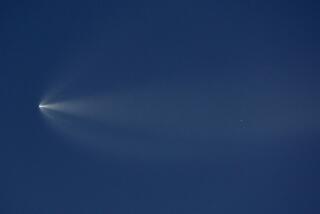Discovery catches a break
- Share via
Catching a break with the Florida weather Friday afternoon, the space shuttle Discovery made a perfect sunset landing at Kennedy Space Center at 5:32 p.m. EST.
Mission controllers had waved off an earlier landing opportunity because of storms and low clouds, but the weather unexpectedly cleared enough to allow the attempt.
Had the weather not cleared at Kennedy, the space shuttle would most likely have had to land at White Sands Space Harbor in New Mexico, the NASA team’s third choice for a landing site.
The primary backup is Edwards Air Force Base in the California’s Mojave Desert, but crosswinds there were too strong, prohibiting a landing attempt.
NASA officials had previously made the decision that they would land Friday at one of the three sites if at all possible because Discovery was running low on supplies, particularly the cryogenic oxygen used in the fuel cells that provide its electricity.
The craft was originally scheduled to land Thursday, but controllers extended the mission a day to allow an unscheduled fourth spacewalk in which astronauts folded a balky solar panel into its container.
The shuttle could have stayed in orbit until Saturday, but the space agency prefers not to allow supplies to get too low in case of unforeseen events.
Weather conditions were perfect at White Sands, but NASA preferred not to use the site because it lacked the heavy equipment necessary to load the shuttle on the back of the agency’s specially equipped Boeing 747 for a return to Kennedy.
A touchdown at White Sands would have delayed the turnaround for Discovery’s next mission by at least six weeks while a crane was brought in and assembled.
Discovery’s seven astronauts were pleased to land at Kennedy because their families were waiting there.
“You have seven thrilled people right here.... I think it’s going to be a great holiday,” Discovery commander Mark Polansky said.
During its 13-day mission, Discovery made 204 orbits of the Earth, traveling 5.33 million miles. It was the craft’s 33rd mission and seventh flight to the International Space Station.
During the mission, the crew delivered and installed a two-ton truss to the station, extending its backbone by 11 feet to 180 feet. When the station is completed the backbone will stretch 250 feet.
In two other spacewalks, astronauts Robert Curbeam and Christer Fuglesang rewired the station to install two new solar panels already in place and to prepare for two more that will be delivered next year.
Discovery also dropped off astronaut Sunita Williams for a six-month stint on the station and brought back Germany’s Thomas Reiter, who had been in space since July.
The next mission is scheduled for March, when the shuttle Atlantis will deliver two more solar panels to the space station.
At least another dozen missions after that will be required to complete the station by the target date of 2010, when the current shuttle fleet is scheduled to be retired.
More to Read
Sign up for Essential California
The most important California stories and recommendations in your inbox every morning.
You may occasionally receive promotional content from the Los Angeles Times.













